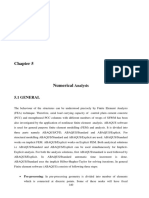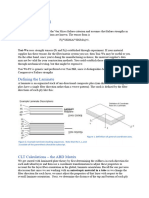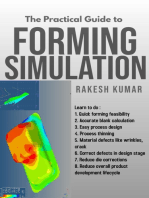MECH3300 Finite Element Methods: - Commercial Packages and How They Work
MECH3300 Finite Element Methods: - Commercial Packages and How They Work
Uploaded by
Nagaraj RamachandrappaCopyright:
Available Formats
MECH3300 Finite Element Methods: - Commercial Packages and How They Work
MECH3300 Finite Element Methods: - Commercial Packages and How They Work
Uploaded by
Nagaraj RamachandrappaOriginal Description:
Original Title
Copyright
Available Formats
Share this document
Did you find this document useful?
Is this content inappropriate?
Copyright:
Available Formats
MECH3300 Finite Element Methods: - Commercial Packages and How They Work
MECH3300 Finite Element Methods: - Commercial Packages and How They Work
Uploaded by
Nagaraj RamachandrappaCopyright:
Available Formats
MECH3300 Finite element Methods
LECTURE 2
- Commercial packages and how they work
Commercial finite element packages
History - initially punched card input and printer output.
The original codes are now the solver, but have graphical
preprocessing and post-processing added.
Geometry can be imported from CAD packages - a standard
format such as IGES may be needed for this. However CAD
geometry is often unsuitable for analysis, as additional
geometric approximations must be made. More later
Appropriate geometry can also be constructed within the finite
element preprocessor (a specialized CAD package).
This typically involves creation of geometry (points, lines,
surfaces and solids), then meshing - creating the actual finite
element model (nodes, elements, restraints, loads, properties
etc).
For analysis of machine components, a finite element package
can be embedded within a solid modeling CAD package, to
automatically mesh CAD solids. This is easy to use, but has
limitations ...
Typical output from a finite element package
Output can be displayed as scaled deflected shapes, contour plots of
stress, animation of deformation, xy plots etc.
Linear v nonlinear analysis
For elastic behaviour and small deflections stress strain and
force deflection. The result for static analysis is a set of linear
equations F=[K]u which can be set up and solved once.
However, if non-linearities are present, an iterative solution is
needed, involving a series of linear approximations. This may
involve 100s of updates to correct for
finite deformation causing shape change (load not deflection),
plastic deformation (stress not strain), creep or
finite sliding in contact or loss of contact (stiffness changes) etc.
Hence nonlinear analysis is much less efficient, and it may
not converge to a solution at all.
Most commercial packages have severe limitations when
applied to nonlinear problems.
Examples of commercial packages
STRAND7 - Australian package mainly for linear structural
analysis - good for beam models - will import solid models but
cannot generate its own solid geometry.
NASTRAN for Windows - mainly for linear structural analysis -
can generate its own solid CAD model.
ABAQUS - written for nonlinear analysis of structures
(nonlinearities include finite deformation, plastic deformation,
sliding contact, loss of contact etc.)
ANSYS - A versatile package that includes capabilities for other
field problems (eg electric and magnetic fields).
LS-DYNA - a package for short duration dynamics such as
impacts - used to simulate car smashes etc.
COSMOS - mainly for linear structural analysis, including
structural optimization. Available embedded in Solid Works.
ADINA - can model fluid-structure interaction, metal forming etc.
All these have some capability to solve dynamics problems.
Researchers
Commercial codes are often developed from research codes
NASTRAN was written for NASA at Univ. of Georgia. It has
been commercialised several times, most successfully by MSC
Software.
DYNA was written by Dr Hallquist and colleagues at University of
California, Lawerence Livermore doing military-funded research.
STRAND started as code developed at Univ. of Sydney and
Univ. of NSW.
Researchers continue to push the limits of what
problems can be solved. Eg at Northwestern
University, Professor Belytschko has recently
been growing cracks through finite element
meshes.
Demonstration versions
Most commercial packages have demonstration versions that are crippled
in various ways to prevent commercial use (eg node limits apply).
STRAND7 demo: available as a .zip file at www.strand7.net.au
It refuses to save a model, but results can be printed.
ABAQUS is available in a 1000 node student version for US$89 with 5%
discount for 10, 10% discount for 20 etc. http://www.worleyparsons.com
50 can be obtained for AUD$97 each including postage.
NASTRAN for Windows demo: available on CD. It will save models and
save results. It requires a 3 month license authorization file to be
downloaded by sending an email from the machine on which Nastran is
installed, to n4w.license@mscsoftware.com
The reply to this message is a file license.dat, which must be placed in the
/solver/conf folder created when Nastran is installed. You need to check that the
.rcf file in this folder contains the line $auth=c:\mscvn4~1\solver\conf\license.dat
What do solvers do?
What happens when you press the solve option on a menu.
SUBTOPICS
1. THE DIRECT STIFFNESS METHOD
2. ASSEMBLY OF ELEMENT MATRICES
3. DEGREES OF FREEDOM IN A STRUCTURE
4. RESTRAINTS [or constraints or freedom conditions]
5. THE SOLUTION PROCESS
The direct stiffness method
Most structures are statically indeterminate, so that loads are shared
between members in accordance with their stiffness. Hence we cant
just use statics.
The direct stiffness method refers to writing a large stiffness matrix to
describe a structure. It was invented as a method of hand calculation,
but only became popular once computers could solve the equations.
Structural equations can be written as displacement = f(loads) giving
compliance or flexibility terms or as loads = f(displacements) giving
stiffness terms.
The advantage of the latter is that it leads to a sparse stiffness matrix,
with non-zero terms only where local interactions between members
or elements occur.
Assembly of element matrices
Imagine expanding each element matrix with rows/columns of
zeroes so that it refers to all displacements at nodes and all
forces at nodes, giving [K
e1
], [K
e2
] etc..
Forces on element 1 are, F
1
= [K
e1
]u where u is the full
displacement vector. F
1
is a column vector of the same size as
u but with zeroes corresponding to nodes not on element 1.
Similarly for element 2, F
2
= [K
e2
]u etc.
Adding forces at nodes EF = {[K
e1
] + [K
e2
] + }u = [K]u
This is a special type of addition called assembly, as the
element matrices are expanded to full size before being added.
Example of assembly- 2 springs in series
Let spring 1 have axial displacements u
1
at node 1 and u
2
at node 2. Its
element equations are
(
=
(
2
1
2
1
u
u
k k
k k
F
F
Ie the force in the spring is its stiffness k times the difference in
displacement over its length. To add another spring in series, add
another node with F
3
and u
3
associated with it. The equations for
spring 1 are now
k k
u
3
u
1
u
2
(
(
(
(
(
(
=
(
(
(
3
2
1
3
2
1
0 0 0
0
0
u
u
u
k k
k k
F
F
F
Spring 1 Spring 2
Example of assembly - 2
For the second spring, its expanded stiffness matrix is that in the eqns.
Adding the forces at nodes
(
(
(
(
(
(
=
(
(
(
3
2
1
32
22
12
0
0
0 0 0
u
u
u
k k
k k
F
F
F
(
(
(
(
(
(
=
(
(
(
+
(
(
(
3
2
1
32
22
12
3
2
1
0
2
0
u
u
u
k k
k k k
k k
F
F
F
F
F
F
Hence the assembled stiffness matrix is
(
(
(
k k
k k k
k k
0
2
0
Note this summation assumes at all elements at a node have the same
displacement - for beams and plates rotations are matched as well, so
this means a joint is always treated as a rigid joint by default, not as a pin
joint.
A row of springs in series
The process of expanding element matrices with zeroes and
adding them can be continued. For instance, for 5 equal springs
end to end, [K] is
(
(
(
(
(
(
(
k k
k k k
k k k
k k k
k k k
k k
0 0 0 0
2 0 0 0
0 2 0 0
0 0 2 0
0 0 0 2
0 0 0 0
Note this matrix is banded - the non-zero terms cluster around the
diagonal and it is symmetric. These properties typically apply to
matrices of structural problems and are exploited in equation
solvers.
Degrees of freedom
Each movement that can occur independently is a degree of
freedom. The total number of degrees of freedom is the number
of equations that must be solved and the size of [K].
For beam or plate models there are potentially 6 degrees of
freedom per node.
For solid models there are potentially 3 degrees of freedom per
node, as no rotations are used to describe the deformation.
The number of degrees of freedom is reduced by applying
restraints or constraints, that stop certain displacements.
At least 6 restraints must be present in 3D to prevent 6 possible
rigid body modes of deformation, as there is no unique solution
to the displacements of an unrestrained structure.
Restraints (or constraints)
The effect of fixing displacement component number i is to
remove row i and column i from the stiffness matrix describing a
structure.
The row is removed as it contains coefficients of a redundant
equation for an unknown reaction to the constraint.
The column is removed as its terms are multiplied by zero.
The effect of these changes is to maintain a symmetric stiffness
matrix.
3 by 3 example - next slide.
3 by 3 example of applying a restraint
Consider the 3 by 3 set of equations below
(
(
(
=
(
(
(
(
(
(
3
2
1
3
2
1
6 5 3
5 4 2
3 2 1
F
F
F
u
u
u
k k k
k k k
k k k
If u
2
= 0 then column 2 of [K] is multiplied by zero, and F
2
becomes
an unknown reaction. Hence we can solve for u
1
and u
3
by solving
(
=
(
3
1
3
1
6 3
3 1
F
F
u
u
k k
k k
Having found u
1
and u
3
we can then find F
2
= k
2
u
1
+ k
5
u
3
if the reaction
is of interest. Finding a reaction may need to be done to check that
the reaction is zero, in a case where the restraint is an artificial one,
applied just to stop rigid body motion.
The solution process
1.Find element stiffness matrix for each member, linking
forces/moments to displacements/rotations at joints. Write
these in the global coordinate system.
2. Add (or assemble) these to give a large matrix [K], by expanding
each member matrix with rows/columns of zeroes.
3. Remove rows and columns of [K] corresponding to any
constrained displacements or rotations. This must be done to
at least prevent any rigid body motion or mechanism.
4. Solve [K] u = F for joint displacements or rotations u.
5. Use each element matrix times relevant displacements to find the
forces/moments on nodes of that element. These imply
internal loadings (eg bending moment), and internal loadings
enable stresses to be found.
Results for a beam model
A beam element loaded at each end only will have linear variation of
bending moment over its length in each principal plane.
Gravity or inertia loading can give a uniform distributed loading. This
leads to quadratic variations of bending moment.
The sign of a moment at a node may be different to that of the
bending moment in the beam there.
Results must be reported in local axes, aligned with the principal
axes of a beam, not in the global axes used to describe the whole
model, in order to distinguish loading causing bending from that
causing twisting or axial loading.
Bending
moment
Local axis directions are determined
by the reference node position.
You might also like
- Kariuki Ouma Ng'etich - Property Law Book - 2016Document518 pagesKariuki Ouma Ng'etich - Property Law Book - 2016Zakariya Mohamed82% (11)
- Athena Cycles: Author Date PurposeDocument11 pagesAthena Cycles: Author Date PurposeJacob Sheridan100% (2)
- FEMAP Tutorial 1Document22 pagesFEMAP Tutorial 1Mohamed AbdouNo ratings yet
- Impact Crusher PDFDocument45 pagesImpact Crusher PDFMusheer BashaNo ratings yet
- Modeling and Numerical Instability ProblemsDocument3 pagesModeling and Numerical Instability ProblemsSunil PandeyNo ratings yet
- Master HH Crash Worthiness P 2Document72 pagesMaster HH Crash Worthiness P 2Jonatan Pozo Palacios100% (1)
- Cad/Cam Lab: Venkitaraj K PDocument60 pagesCad/Cam Lab: Venkitaraj K PJoe mNo ratings yet
- Introduction To Finite Element Analysis in Solid MechanicsDocument15 pagesIntroduction To Finite Element Analysis in Solid MechanicsAditya AgrawalNo ratings yet
- Nastran StaticDocument61 pagesNastran StaticRohit AcharyaNo ratings yet
- CAMA Lab IntroductionDocument22 pagesCAMA Lab IntroductionDr. Rishi J PNo ratings yet
- CAE TheoryDocument30 pagesCAE TheorySuhas ShindeNo ratings yet
- Tutorial1-2 ElasticCantilever V4Document29 pagesTutorial1-2 ElasticCantilever V4abuumayrNo ratings yet
- Intro To FEA PDFDocument20 pagesIntro To FEA PDFxyz GonNo ratings yet
- Chapter 5 - Numerical AnalysisDocument41 pagesChapter 5 - Numerical AnalysisMohammed HammadNo ratings yet
- Structural AnalysisDocument7 pagesStructural Analysisdhanya1995No ratings yet
- Introduction To Finite Element Analysis in Solid Mechanics: Home Quick Navigation Problems FEA CodesDocument25 pagesIntroduction To Finite Element Analysis in Solid Mechanics: Home Quick Navigation Problems FEA CodespalgunahgNo ratings yet
- Frame - Portal and Gable Rigid Plane Frame AnalysisDocument6 pagesFrame - Portal and Gable Rigid Plane Frame Analysisnamasral100% (4)
- Stiffness MatrixDocument22 pagesStiffness MatrixArun Sunny100% (1)
- FEM BasicDocument70 pagesFEM Basicformech100% (1)
- Comparative Analysis of KL and SA Partitioning Algorithms Implemented On VLSI Circuit PartitioningDocument7 pagesComparative Analysis of KL and SA Partitioning Algorithms Implemented On VLSI Circuit Partitioningwww.irjes.comNo ratings yet
- SimXpert R3.2 Modeling GuideDocument202 pagesSimXpert R3.2 Modeling Guidepaulkastle100% (2)
- Dynamic Finite Element MethodsDocument29 pagesDynamic Finite Element MethodsVns VnsNo ratings yet
- Beams Deflection - Macaulay's MethodDocument4 pagesBeams Deflection - Macaulay's MethodYadanaNo ratings yet
- CAD Project 05 Report FinalDocument52 pagesCAD Project 05 Report Finalsidhant_rockNo ratings yet
- Abaqus Assignment 1Document6 pagesAbaqus Assignment 1Flávia de Souza BastosNo ratings yet
- ANSYS Version 10Document6 pagesANSYS Version 10pankaj0983No ratings yet
- ProblemDocument3 pagesProblemHaldor8No ratings yet
- Modeling - Rigid End OffsetsDocument7 pagesModeling - Rigid End OffsetsAnonymous DNb6yWERfB100% (1)
- NozzleproDocument20 pagesNozzleprossmith2007No ratings yet
- SFrame (6705)Document91 pagesSFrame (6705)hossinmaaNo ratings yet
- Chapter 8 - LoadingDocument8 pagesChapter 8 - LoadingmuhdqasimNo ratings yet
- NonlinearAnalysis of StructuresDocument30 pagesNonlinearAnalysis of StructuresUmut Akın100% (1)
- Module 2 - VlsiDocument36 pagesModule 2 - VlsiMegha ShreeNo ratings yet
- Finite Element Analysis of Arch DamDocument8 pagesFinite Element Analysis of Arch Damd4891No ratings yet
- Simulation Lab-2022-23-ManualDocument22 pagesSimulation Lab-2022-23-ManualChiru MNo ratings yet
- 1.4.1 Loading Conditions: Module 1: Introduction To Finite Element Analysis Lecture 4: Steps in Finite Element AnalysisDocument7 pages1.4.1 Loading Conditions: Module 1: Introduction To Finite Element Analysis Lecture 4: Steps in Finite Element AnalysisB S Praveen BspNo ratings yet
- (2002) A Finite-Element Model For The Analysis of Wrinkled Membrane StructuresDocument21 pages(2002) A Finite-Element Model For The Analysis of Wrinkled Membrane StructuresGregorius FilipusNo ratings yet
- Answer 1Document2 pagesAnswer 1Shubham imtsNo ratings yet
- RuaumokoDocument23 pagesRuaumokoalfredobaezNo ratings yet
- 1112012913dynamics Response Spectrum Analysis PDFDocument33 pages1112012913dynamics Response Spectrum Analysis PDFHectoreRodriguezlNo ratings yet
- Module 1: Introduction To Finite Element Analysis Lecture 1: IntroductionDocument6 pagesModule 1: Introduction To Finite Element Analysis Lecture 1: IntroductionMuhammad DaniyalNo ratings yet
- "Frame" - Portal and Gable Rigid Plane Frame Analysis: Program DescriptionDocument12 pages"Frame" - Portal and Gable Rigid Plane Frame Analysis: Program DescriptionCharles Rodríguez SalinasNo ratings yet
- Introduction To Matrix Methods in Structural Mechanics Contents - 1 RevisionDocument33 pagesIntroduction To Matrix Methods in Structural Mechanics Contents - 1 RevisionEyuel ZebeneNo ratings yet
- Slab in ETABS, Shell or MembraneDocument14 pagesSlab in ETABS, Shell or MembraneNaveen Revanna100% (1)
- FEM AssignmentDocument8 pagesFEM AssignmentVijay KumarNo ratings yet
- Chapter 3: Methodology For Finite Element AnalysisDocument13 pagesChapter 3: Methodology For Finite Element Analysissju65No ratings yet
- Me - Fea 2024-05-02 10 - 34 - 37Document47 pagesMe - Fea 2024-05-02 10 - 34 - 37a.runcianu-20No ratings yet
- Fea Lab Manual PDFDocument57 pagesFea Lab Manual PDFKrishna Kalyan100% (1)
- Tsai Wu or Tsai HillDocument6 pagesTsai Wu or Tsai Hillsiginanu14No ratings yet
- Finite Elements for Truss and Frame Structures: An Introduction Based on the Computer Algebra System MaximaFrom EverandFinite Elements for Truss and Frame Structures: An Introduction Based on the Computer Algebra System MaximaNo ratings yet
- Standard-Slope Integration: A New Approach to Numerical IntegrationFrom EverandStandard-Slope Integration: A New Approach to Numerical IntegrationNo ratings yet
- Method of Moments for 2D Scattering Problems: Basic Concepts and ApplicationsFrom EverandMethod of Moments for 2D Scattering Problems: Basic Concepts and ApplicationsNo ratings yet
- Level Set Method: Advancing Computer Vision, Exploring the Level Set MethodFrom EverandLevel Set Method: Advancing Computer Vision, Exploring the Level Set MethodNo ratings yet
- Robot Manipulators: Modeling, Performance Analysis and ControlFrom EverandRobot Manipulators: Modeling, Performance Analysis and ControlNo ratings yet
- Athanasios Theos Thesis 2005Document167 pagesAthanasios Theos Thesis 2005Bosco RajuNo ratings yet
- Fatigue and Damage Tolerance: Edward Herba, January 29,2004Document38 pagesFatigue and Damage Tolerance: Edward Herba, January 29,2004Nagaraj RamachandrappaNo ratings yet
- Heat Transfer Fluent TrainingDocument37 pagesHeat Transfer Fluent TrainingbastinaduNo ratings yet
- NonLinearAnalysis NASTRANDocument14 pagesNonLinearAnalysis NASTRANNagaraj RamachandrappaNo ratings yet
- Working Drawings: S. P. GaikwadDocument45 pagesWorking Drawings: S. P. GaikwadNagaraj RamachandrappaNo ratings yet
- Commercial and Military Aircraft Line DrawingsDocument157 pagesCommercial and Military Aircraft Line Drawingsmakghule100% (5)
- Airplane Stress Analysis NACA TR 82 1918Document72 pagesAirplane Stress Analysis NACA TR 82 1918brkappaNo ratings yet
- Durability Analysis Method For Nonstationary Random VibrationDocument82 pagesDurability Analysis Method For Nonstationary Random VibrationNagaraj RamachandrappaNo ratings yet
- l5 Quasi StaticDocument33 pagesl5 Quasi StaticFahmiNo ratings yet
- AB 2030 Rev. 07.09: Red Cedar Technology, IncDocument4 pagesAB 2030 Rev. 07.09: Red Cedar Technology, IncNagaraj RamachandrappaNo ratings yet
- Geom Nonlinear TutorialDocument14 pagesGeom Nonlinear TutorialNagaraj RamachandrappaNo ratings yet
- Mode-Based SIM BeTSSiDocument9 pagesMode-Based SIM BeTSSiNagaraj RamachandrappaNo ratings yet
- Introduction - 2 Topics: Airplane Design (Aerodynamic) Prof. E.G. Tulapurkara Chapter-1Document10 pagesIntroduction - 2 Topics: Airplane Design (Aerodynamic) Prof. E.G. Tulapurkara Chapter-1Nagaraj RamachandrappaNo ratings yet
- Abaqus Explicit VUMAT For HysteresisDocument5 pagesAbaqus Explicit VUMAT For HysteresisNagaraj Ramachandrappa100% (2)
- 2-Lectures LEC 19 Modifications of The Mohr Theory For Brittle MaterialsDocument41 pages2-Lectures LEC 19 Modifications of The Mohr Theory For Brittle MaterialsNagaraj RamachandrappaNo ratings yet
- Bolt Studio ManualDocument7 pagesBolt Studio ManualNagaraj RamachandrappaNo ratings yet
- Torsion of Multi-Cell Cross-Section - Hw7 - BDocument12 pagesTorsion of Multi-Cell Cross-Section - Hw7 - BNagaraj RamachandrappaNo ratings yet
- Wavelet Step by StepDocument2 pagesWavelet Step by StepazizcrNo ratings yet
- A Study On Effective Cash Management System Performance in Abc Techno Labs India Private LimitedDocument8 pagesA Study On Effective Cash Management System Performance in Abc Techno Labs India Private LimitedBabasaheb JawalgeNo ratings yet
- Worksheet With Answer KeyDocument8 pagesWorksheet With Answer Keyapi-213604106No ratings yet
- Army Vaccination Centres 2021-08-27Document2 pagesArmy Vaccination Centres 2021-08-27Adaderana OnlineNo ratings yet
- Pre-Spud Checklist # 4Document2 pagesPre-Spud Checklist # 4Yougchu LuanNo ratings yet
- Gatchalian v. CollectorDocument10 pagesGatchalian v. Collectorbrida athenaNo ratings yet
- TCP-IP Unleashed, Third EditionDocument1,117 pagesTCP-IP Unleashed, Third Editiongopi_merugu100% (4)
- FALAJ AND IRON AGE SolvedDocument3 pagesFALAJ AND IRON AGE Solveddeborah hildaNo ratings yet
- MAricultura Artigo Internacional 2021Document18 pagesMAricultura Artigo Internacional 2021paula.ritterNo ratings yet
- Zaiger Motion To ContinueDocument2 pagesZaiger Motion To ContinueSusanBaskoNo ratings yet
- Representing Linear Systems With Matrices (Article) - Khan AcademyDocument12 pagesRepresenting Linear Systems With Matrices (Article) - Khan AcademyAshekin MahadiNo ratings yet
- Pecs Self-Rating Questionnaire Corrected Score SheetDocument2 pagesPecs Self-Rating Questionnaire Corrected Score SheetPrincess Faniega SugatonNo ratings yet
- Impact of Social MediaDocument7 pagesImpact of Social MediaVikram SahaNo ratings yet
- Designer Baskets, Inc. v. Air Sea Transport, IncDocument6 pagesDesigner Baskets, Inc. v. Air Sea Transport, IncMoyna Ferina RafananNo ratings yet
- Tamilnadu Newsprint and Papers Limited: Sl. No. Name of The Posts No. of Posts Reservation Scale of Pay / Monthly CTCDocument8 pagesTamilnadu Newsprint and Papers Limited: Sl. No. Name of The Posts No. of Posts Reservation Scale of Pay / Monthly CTCV. Krishna ThejaNo ratings yet
- UCM224D - Technical Data SheetDocument8 pagesUCM224D - Technical Data Sheet3efooNo ratings yet
- ENG-PST Lecture2Document25 pagesENG-PST Lecture2Abdulrahman AlhomsiNo ratings yet
- VANSHIKA Statement of Purpose Curtin UniDocument2 pagesVANSHIKA Statement of Purpose Curtin Unibsaroj921No ratings yet
- Punjab Waqf Rules, 2018Document46 pagesPunjab Waqf Rules, 2018Loveroop SinghNo ratings yet
- 1561 1599Document12 pages1561 1599WesNo ratings yet
- Introduction To Wing DesignDocument9 pagesIntroduction To Wing DesignJef LeNo ratings yet
- Conveyor Products1Document23 pagesConveyor Products1vegamarco80No ratings yet
- Lokasi Komponen AC Innova RebornDocument4 pagesLokasi Komponen AC Innova RebornNursamsudin NursamsudinNo ratings yet
- Single Sheeter Low Rise Floors February 2023Document4 pagesSingle Sheeter Low Rise Floors February 2023Hritik SharmaNo ratings yet
- Instructions For MMW ProjectsDocument2 pagesInstructions For MMW ProjectsChi De LeonNo ratings yet
- HEAT EXCHANGERS MDocument143 pagesHEAT EXCHANGERS MHeet Patel100% (1)
- Locator SlipDocument5 pagesLocator SlipCharish CatungalNo ratings yet
- Zanussi ZWY 61004 WA Washing MachineDocument36 pagesZanussi ZWY 61004 WA Washing MachineahmedNo ratings yet











































































































